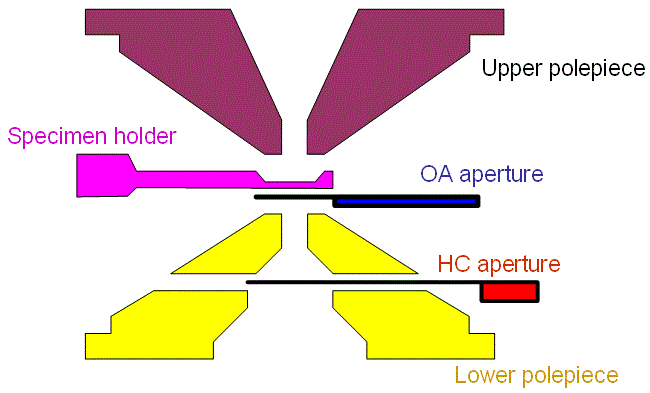The schematic illustration of JEM-2010F objective lens in Figure 3266 presents the typical objective lens in conventional TEMs. The specimen (for side-entry holder) is located at the center of the polepieces. Thee objective aperture (OA) is placed immediately below the specimen and the high contrast (HC) aperture goes through the lower polepiece.

Figure 3266. Typical objective lens in conventional TEMs.
In general, side-entry TEM/STEM holders have the properties as follows:
a) Setup
a.i) The traditional side-entry holder is rod-shaped with a motor attached to tilt about two axes at right angles and/or rotate the specimen 360° about the optical axis. The tip of the side-entry holder is normally fitted with a jeweled bearing.
a.ii) The cylindrical or flattened rod is laterally inserted into the objective pole-piece through an airlock on one side of the column, and a wire connects it to a power supply and controller.
a.iii) One or two specimens are placed at the end of the long rod and the tilts up to ±70° can be made in any directions. The specimens are secured by a clamp and spring mechanism. However, in order to insert the tilting holder, the side-entry pole piece requires a comparatively wide gap.
a.iv) The drive (goniometer stage) moves the specimen holder back and forth to position the specimen in the electron beam. The stage motion is normally limited to about ±1 mm in the X- and Y- directions, and thus specimen size is very limited.
a.v) Several designs for fully bakable UHV HRTEM stages have also been used in which a side-entry mechanism is employed with a detachable tip so that the transfer rod can be withdrawn.
a.vi) Recently designed side-entry stages can almost compete with top-entry stages with respect to resolution and stability.
b) Advantages:
b.i) Most TEMs employ side-entry stages because it allows more versatility in positioning the specimen, and the design of the device (goniometer) for tilting the specimen is also simpler.
b.ii) A rod with a motor is attached to tilt and/or rotate the specimen and a wire connects it to a power supply and control box.
b.iii) Using height adjustment for the specimen with goniometer stages, eucentric position can be obtained. Therefore, even if the specimen moves away from the selected area at high tilts, it will not be far from the starting position.
b.iv) Heating, cooling, straining the specimen, and chemical growth of materials can usually be done at the expenses of resolution and specimen tilt. For instance, we can have direct access to electrically heating the specimen and transfer of gases and liquids via a rod.
b.v) They permit in-plane rotation, either 360° or ±180°.
c) Disadvantages:
c.i) Shielded objective pole pieces have to be used.
c.ii) Usually requires a wider objective lens gap which degrades the instrument's analytical properties.
c.iii) They are susceptible to vibrations and thermal drift (The rod serves as a transmitter of vibration and heat), which are considerably higher than that for top-entry stages.
Comparing with side-entry specimen stages, top-entry specimen stages have better probe system parameters (e.g. Cs and Cc), and the X-ray spectrometers closer to the specimen.
|